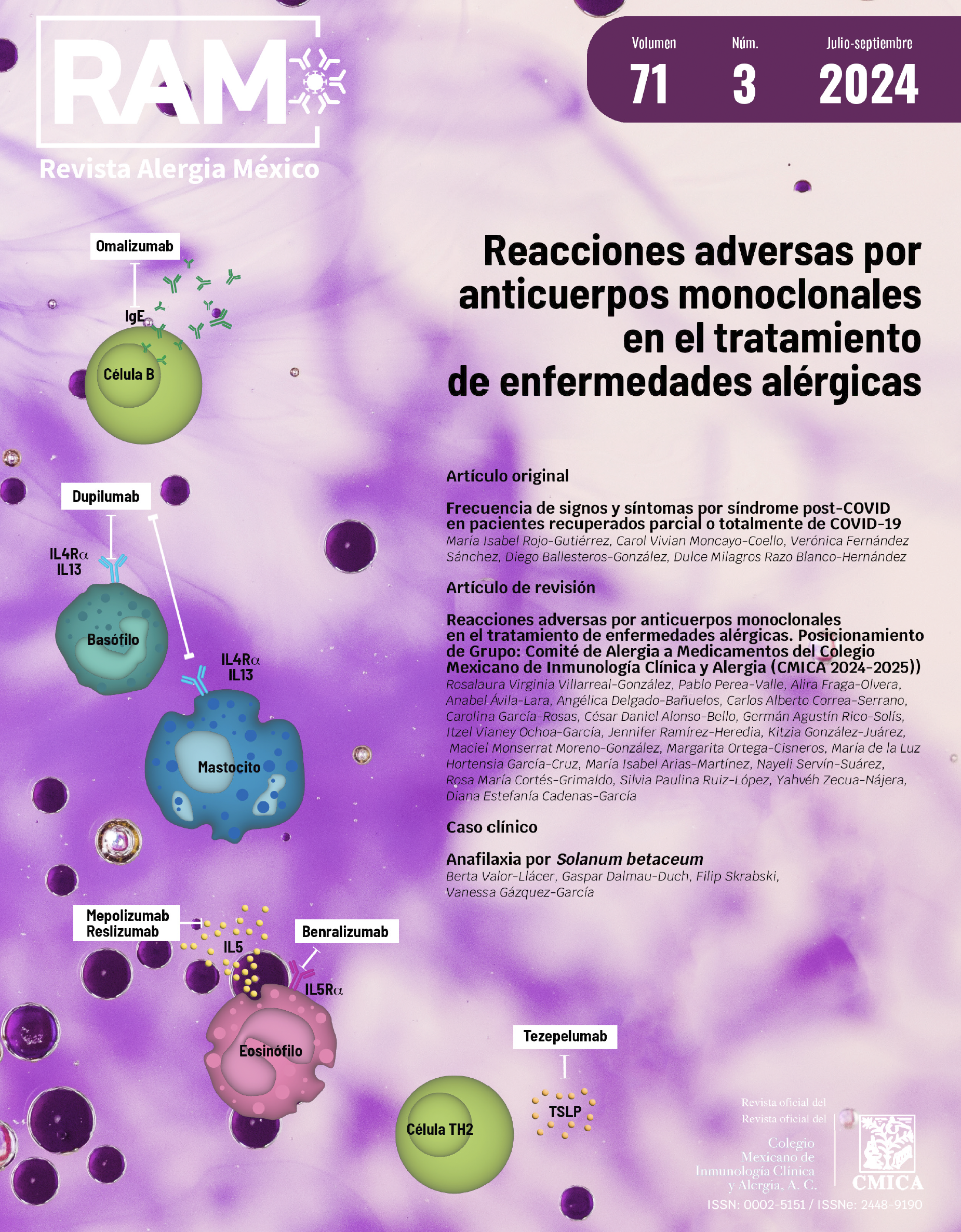Abstract
Objective: To determine the prevalence and evaluate the distribution of sensitization to aeroallergens in pediatric and adult patients with allergic rhinitis.
Methods: Observational, cross-sectional and retrospective study, carried out from the analysis of clinical records of patients with skin tests, to intentionally identify signs and symptoms of allergic rhinitis, as well as aeroallergens to which they reacted positively.
Results: 1531 skin reactivity tests were reviewed, of which 983 corresponded to patients with a diagnosis of allergic rhinitis with a positive test. The prevalence of the disease was 64.2% (n = 983); the pediatric population had a prevalence of 55.8% (n = 549) and the adult population 44.1% (n = 434). The aeroallergens with the highest frequency of sensitization were: Dermatophagoides pteronyssinus (59.5%), Dermatophagoides farinae (45.3%), cat (26.1%), Cupressus arizonica (21.7%), dog (21.6%) and Fraxinus excelsior ([Ash], 19.6%).
Conclusion: There is a high prevalence of allergic rhinitis in the studied cohort. The house dust mites Dermatophagoides mix (Pteronyssinus and Farinae) were the main allergens. Cosensitization to cat and dog was high. The tree pollen species with the highest impact were: Cupressus arizonica, Fraxinus excelsior and Quercus robur (Roble, Encino, Oak). The grass pollen varieties with the greatest influence: Cynodon dactylon (Bermuda, Capriola) and Lolium Perenne (English grass).
Keywords: Allergens; Allergic rhinitis; Prevalence; Skin tests; Mexico.
References
1. Kliegman RM. Rinitis Alérgica. En: Nelson. Tratado de pediatría. Elsevier España, S.L.U.; 2020; 1: 1179-1185.
2. Mullol J, Valero A. Actualización del manejo de la rinitis alérgica. Guías GEMA y MACVIA-ARIA. Rev Rinol. 2019; 19 (1): 7-18.
3. Lopez Perez G, Díaz-Narváez L. Rinitis alérgica: a propósito de la llegada de la primavera. Acta Pediatr Mex 2023; 44 (2): 161-166. doi: 10.18233/apm.v44i2.2646
4. Richard DS, Stephen FK. Pathogenesis of allergic rhinitis (rhinosinusitis). In: UpToDate, Jonathan C (Ed), UpToDate, Waltham, MA. https://www.uptodate.com/contents/pathogenesis-of-allergic-rhinitis-rhinosinusitis
5. Richard DS, Stephen FK. Allergic rhinitis: Clinical manifestations, epidemiology, and diagnosis. In: UpToDate, Jonathan C (Ed), UpToDate, Waltham, MA. https://www.uptodate.com/contents/allergic-rhinitis-clinical-manifestations-epidemiology-and-diagnosis
6. Seidman MD, Gurgel RK, Lin SY, et al. Clinical practice guideline: Allergic rhinitis. Otolaryngol Head Neck Surg 2015; 152 (S1). doi: 10.1177/0194599814561600
7. Larenas-Linnemann D, Mayorga-Butrón JL, Sánchez-González A, et al. ARIA México 2014. Adaptación de la Guía de Práctica Clínica ARIA 2010 para México. Metodología ADAPTE. Rev Alerg Mex 2014; 61: S3-116. doi: 10.29262/ram.v61i0.52
8. Mancilla-Hernández E, Barnica R, González-Solórzano E, et al. Prevalencia de rinitis alérgica y factores asociados en estudiantes mexicanos. Un estudio multicéntrico. Rev Alerg Mex 2021; 68 (2): 101-111. doi: 10.29262/ram.v658i2.786
9. Larenas-Linnemann D, Luna-Pech J, Rodríguez-Pérez N, et al. Guía de diagnóstico de alergia mediada por IgE e inmunoterapia aplicando el método ADAPTE. Rev Alerg Mex 2019; 66 (5): 1-105. doi: 10.29262/ram.v66i5.631
10. Pokharel M, Shrestha BL, Karn D, et al. Prevalence of Aeroallergens in Allergic Rhinitis in a Tertiary Care Hospital. JNMA J Nepal Med Assoc 2020; 58 (231): 866-870. doi: 10.31729/jnma.5218
11. Ansotegui IJ, Melioli G, Canonica GW, et al. IgE allergy diagnostics and other relevant tests in allergy, a World Allergy Organization position paper. World Allergy Organ J 2020; 13 (2): 100080. doi: 10.1016/j.waojou.2019.100080
12. Katel P, Pinkaew B, Talek K, Tantilipikorn P. Pattern of Aeroallergen Sensitization and Quality of Life in Adult Thai Patients With Allergic Rhinitis. Front Allergy 2021; 2. doi: 10.3389/falgy.2021.695055
13. Santana C, Rivas C, García ME. Aeroalérgenos: pólenes, ácaros, hongos, animales y otros. Medidas de evitación. Protoc Diagn Ter Pediatr 2019; 2: 65-85.
14. Suárez-Gutiérrez M, Macías-Garza JE, López-Ortiz DJ, et al. Sensibilización a aeroalérgenos en pacientes con rinitis alérgica en Aguascalientes, México. Rev Alerg Mex 2020; 66 (4): 388-393. doi: 10.29262/ram.v66i4.634
15. Larenas-Linnemann D, Michels A, Dinger H, et al. Allergen sensitization linked to climate and age, not to intermittent-persistent rhinitis in a cross-sectional cohort study in the (sub)tropics. Clin Transl Allergy 2014; 4: 20. doi: 10.1186/2045-7022-4-20
16. Climatología. Instituto Nacional de Estadística y Geografía (INEGI). https://www.inegi.org.mx/temas/climatologia/. Accedido el 26 de enero de 2024.
17. Sánchez J, Diez LS, Cardona R. Frecuencia de sensibilización a animales en un área tropical. Rev Alerg Mex 2014; 61 (2): 81-89. doi: 10.29262/ram.v61i2.30
18. Soto AS, Partida GA, Romero PMS, et al. Análisis descriptivo de la sensibilización a alérgenos en una población pediátrica. Alerg Asma Inmunol Pediatr 2015; 24 (2): 40-53.
19. Gaspar-López A, López-Rocha EG, Rodríguez-Mireles KA, et al. Prevalencia de polinosis en pacientes con asma, rinitis y conjuntivitis alérgicas en la zona sur del Distrito Federal, 2007-2013. Rev Alerg Mex 2014; 61 (3): 147-152. doi: 10.29262/ram.v61i3.39
20. González-Mendoza T, Bedolla-Barajas M, Bedolla-Pulido TR et al. La prevalencia de rinitis alérgica y dermatitis atópica en adolescentes tardíos difiere de acuerdo con el sexo. Rev Alerg Mex 2019; 66 (2): 147. doi: 10.29262/ram.v66i2.521
21. Pinart M, Keller T, Reich A et al. Sex-Related Allergic Rhinitis Prevalence Switch from Childhood to Adulthood: A Systematic Review and Meta-Analysis. Int Arch Allergy Immunol 2017; 172 (4): 224-235. doi: 10.1159/000464324

This work is licensed under a Creative Commons Attribution-NonCommercial 4.0 International License.
Copyright (c) 2025 Revista Alergia México

